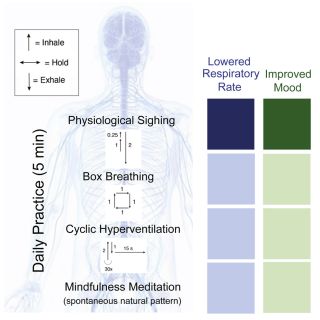Stress
How Longer Exhalations and Cyclic Sighing Make Us Feel Good
Exhale-focused cyclic sighing hacks the vagus nerve and reduces stress.
Posted January 23, 2023 Reviewed by Devon Frye
Key points
- Controlled breathwork practices that focus on different inhalation/exhalation ratios are a well-established way to reduce stress.
- Mindfulness meditation practices are also widely used by people who want to lower stress levels and keep their anxiety in check.
- A new study compared the stress-reducing efficacy of mindfulness vs. three types of breathwork. The winner: Exhale-focused cyclic sighing.
New research reaffirms what many of us have known for years: Longer exhalations calm the autonomic nervous system, reduce physiological arousal, lower stress, and take the edge off anxiety.

Four years ago, in a 2019 blog post, "Longer Exhalations Are an Easy Way to Hack Your Vagus Nerve," I wrote about the psychophysiological benefits of a controlled breathing exercise that emphasizes a 1:2 inhalation/exhalation ratio (e.g., 4-second inhalation: 8-second exhalation). A new study (Balban et al., 2023) from Stanford University gives us fresh evidence that people who practiced what they call "cyclic sighing" breathwork marked by a 1:2 inhale/exhale ratio for 5 minutes per day for four weeks (28 days) experienced reduced physiological arousal, less perceived stress, and enhanced mood. These findings were recently published in the peer-reviewed journal Cell Reports Medicine.
For this randomized controlled study, the Stanford researchers recruited 108 volunteers and randomly assigned them to four different groups. Each group performed a specific type of breathwork exercise or a "forehead-focused" mindfulness meditation exercise for 5 minutes per day for 28 days.
3 Controlled Breathwork Practices Examined in This Study
- Exhale-focused cyclic sighing: Emphasizes shorter inhalations and prolonged exhalations. (1:2 ratio)
- Box breathing: Emphasizes equal duration of inhalation, breath retention, and exhalation. (1:1:1 ratio)
- Cyclic hyperventilation: Emphasizes robust inhalation, short retention, and rapid exhalation.
Of the 108 human subjects enrolled in this study, 33 were in the cyclic hyperventilation group, 30 did exhale-focused cyclic sighing, 21 were in the box breathing group, and 24 were randomly assigned to a mindfulness meditation control group. The researchers' goal was to see which of these stress-reduction techniques was most effective at reducing physiological arousal and enhancing mood.
Among these four groups, the mindfulness meditation group was the only one not given specific inhale/exhale breathwork instructions. Instead, they were simply told to "focus your mental attention on the forehead region between your two eyes." If someone's focus drifted away from that area during this daily 5-minute mindfulness exercise, they were instructed to "re-recenter your attention by focusing back first on your breath and then on the forehead region between your eyes."
Exhale-Focused Cyclic Sighing Was the Best Stress-Buster
Although all four stress-reduction interventions used in this study had positive effects, people in the exhale-focused cyclic sighing group got the best results. On a continuum, all three controlled breathwork exercises lowered stress more effectively than doing a forehead-focused mindfulness exercise.
Notably, of the three controlled breathwork interventions used for this study, exhale-focused cyclic sighing, marked by a 1:2 inhalation/exhalation ratio, most effectively reduced physiological arousal and enhanced mood.
"Participants in the exhale-emphasized cyclic sighing group had the highest increase in positive affect throughout the course of the one-month study," the authors explain. "We found that the cyclic sighing group had a significantly higher increase in positive affect than those in the mindfulness meditation group. The other two breathwork groups were also higher than mindfulness meditation; however, this difference was not significant."
Why Do Longer Exhalations Reduce Stress So Well?
Longer exhalations stimulate the vagus nerve in ways that reduce fight-or-flight stress responses on a physiological level (Gerritsen & Band, 2018). The ability of different breathing techniques to modulate vagal function and kickstart the parasympathetic nervous system’s "relaxation response" is well established.
Heart rate variability (HRV) is commonly used to gauge vagus nerve activity and index vagal tone. In future research, Balban et al. plan to focus on how different types of breathwork affect HRV and the vagus nerve.
"[It] is reasonable to assume that the effect of deliberate breathing practices on brain function is, at least in part, mediated by vagus nerve pathways," the authors conclude. "In future studies, we plan to explore the specific brain regions activated by particular patterns of breathing and correlate those with vagal recordings and heart rate variability (HRV)."
References
elis Yilmaz Balban, Eric Neri, Manuela M. Kogon, Jamie M. Zeitzer, David Spiegel, Andrew D. Huberman. "Brief Structured Respiration Practices Enhance Mood and Reduce Physiological Arousal." Cell Reports Medicine (First published: January 10, 2023) DOI: 10.1016/j.xcrm.2022.100895
Roderik J. S. Gerritsen and Guido P. H. Band. "Breath of Life: The Respiratory Vagal Stimulation Model of Contemplative Activity." Frontiers in Human Neuroscience (First published: October 09, 2018) DOI: 10.3389/fnhum.2018.00397


